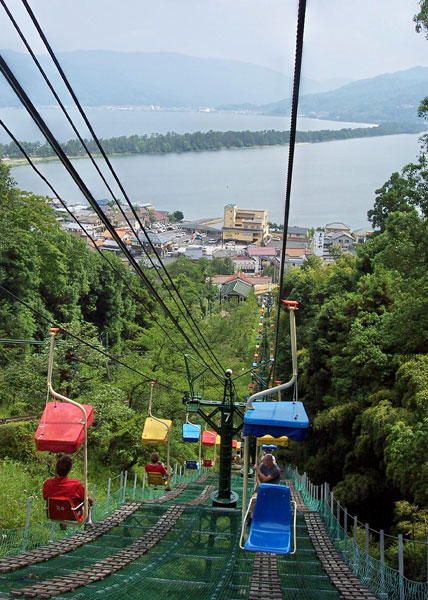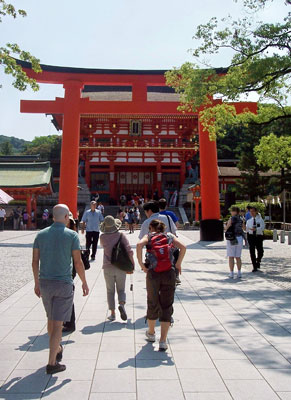Japan Kyōto and Kinosaki
This item appears on page 62 of the December 2014 issue.
(First of two parts)
In late June of 2014 I, along with two other journalists, participated in a trip through Japan’s Kansai region as a guest of the local tourism board. Our 6-day journey focused on utilizing the very efficient railway system to explore the Kyōto, Kinosaki, Osaka and Nara areas of Kansai.
Being an aficionado of both Japanese cuisine and many aspects of the culture in general, this adventure was right up my alley.
We were accompanied throughout the trip by the guide Michiko Moriwaki and by Takayoshi Okumura of the Kansai International Tourism Promotion Center.
Kyōto and surrounds
With travel primarily by rail, our initial touring day in the expansive Kyōto City area was a nonstop whirlwind of activity.
First up was the impressive Fushimi-Inari Shrine, only a 5-minute ride on the Japan Rail line from Kyōto Station. The shrine is famous for its thousands of vermilion gates, which straddle an extensive network of trails leading into the wooded forest of sacred Mount Inari. One trail eventually climbs to a peak at 233 meters, offering broad views over Kyōto.
Fushimi-Inari is the most important of several thousand shrines dedicated to Inari, the Shinto god of rice. Our schedule didn’t allow time for us to climb to the peak, but, given the heat, perhaps that was a blessing.
We hopped back on the rail to Uji and the beautiful, 11th-century Byodo-in Temple, a UNESCO World Heritage Site that is popular with visitors. The finest elements of imperial culture were brought together to construct the main hall, and the spectacular ancient architecture remains unchanged today.
Uji was also the starting point of our journey-long “green tea exposure,” as we participated in an educational traditional green tea ceremony at Taiho-an tea house (1-5 Uji, Togawa, Uji City; phone 0774 23 3334). At 500 yen, about $5, the ceremony is a bargain.
Gion treasures
From Uji, we continued by train to the Gion section of Kyōto City, first visiting the ornate, Shinto Yasaka Shrine, originally built to expel the epidemics of disease in the 17th century. It is praised today as something of a good-luck charm that can bring people prosperity and protect them from illness.
The natural beauty of the mountains frames the majestic 3-level pagoda of Kiyomizu Temple, which was our next stop. A World Heritage Site, the 15-story-high main wooden structure was completed without the use of nails — an impressive feat in any century. Superb views of Kyōto City are possible from some of the halls on the temple’s top level.
We also wandered the streets of Gion, birthplace of the Geisha culture, where visitors try to spot the elusive Geisha in what seems to be something of an on-foot photo safari experience. After enjoying a Kyōto-style shabu-shabu (beef-and-seafood hot pot) dinner in Gion, two of us finally managed to spot and photograph two lovely Geisha prey.
In Gion, I was amazed by the number of younger (20s) female and male tourists from surrounding Asian countries who were strolling the areas around the temples dressed in traditional Japanese costume. We were advised this is a very popular visitor pastime, although I never quite understood why.
Our movements on this day were managed by three well-coordinated train transfers and a final taxi ride back to our hotel after dinner. My recommendation for most visitors would be to take a minimum of two full days to do what we deftly managed in one with our expert guides.
Amanohashidate bound
The following morning, we traveled by limited express train through the inviting green Kansai countryside to Nishi-Maizuru. There we switched to the decorative, 2-car Alcamatsu tourist train for a leisurely ride to Amanohashidate, considered one of the three most scenic spots in Japan.
The area’s main feature is a narrow, 3.6-kilometer-long sandbar with more than 8,000 pine trees cradled by the pristine waters of the Aso Sea and Miyazu Bay.
On arrival, we briefly visited Chionji (god of learning) Temple, followed by a relaxing bicycle ride across the beautiful forested sand spit to Moto-Ise Shrine. After taking a chair lift to enjoy the sweeping views overlooking Amanohashidate, we returned to the main village by boat and continued to Kinosaki, our overnight destination.
Kinosaki dreaming
It was early evening when we arrived at one of Japan’s premier hot springs destinations, Kinosaki and the ryokan (traditional-style hotel) Nishimuraya Shogetsutei (1016-2 Yushima, Kinosaki-cho, Toyooka City, Hyogo Pref., Japan 669-6101; www.nishimuraya.ne.jp/shogetsu/en). Upon checking in, there was just enough time to get in a quick soak at the hotel baths before our formal Japanese dinner.
Mostly, I wanted to get familiar with the baths process, as I was planning to visit several of the town’s seven public hot spring bath facilities after dinner. We had only one night in this paradise and I needed to make the most of it.
Visitors staying at any local ryokan can use Kinosaki’s seven public bathhouses without paying admission charges. In order to gain free admission, you need to wear the ryokan’s yukata (kimono) and carry admission coupons provided by the ryokan.
Upon the completion of our lengthy dinner, one of our trip hosts, Mr. Okumura, and I managed to visit and enjoy the hot springs at four of the seven public bath houses: Jizo-yu, Mandara-yu, Ichino-yu and Goshono-yu. The following day we were dubbed the “hot springs express” by the rest of our group.
While we had only a one-night whistle stop in Kinosaki, I would recommend a minimum of two nights or, for hot springs aficionados, three or more.
The rooms in our traditional-style Japanese hotel were quite large. In the main room of each, a sitting table magically disappeared in the evening, replaced by a comfortable sleeping mat on the floor. It was a most enjoyable cultural experience but, for me, would take some conditioning to get used to as a constant. Room prices range from $320 to $550 per night.
In next month’s column, I will report on the Osaka area of Japan’s Kansai region.
Before you go…
The all-encompassing information source for Kansai is the website of the Kansai International Tourism Promotion Center, www.kansai.gr.jp. On the website, go to “Sightseeing” and also “100 Hot Spots.” You will also find detailed information about the four railways that operate in Kansai.
You may reach Randy at 80 America Way, Jamestown, RI 02835; 401/560-0350, randykeck@yahoo.com.



